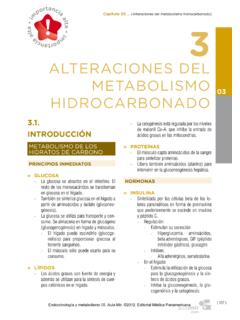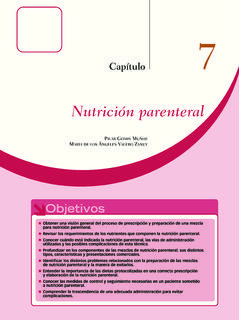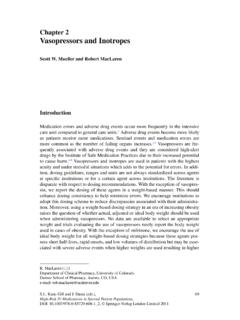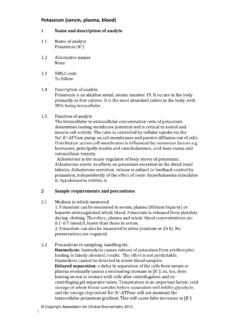Transcription of Interpretation of Urine Electrolytes and Osmolality …
1 13 Chapter 2 Interpretation of Urine Electrolytes and OsmolalityA. S. Reddi, Fluid, electrolyte and Acid-Base Disorders, DOI , Springer Science+Business Media New York 2014 Measurement of Urine Na + , Cl , and K + is rather common in hospitalized patients, and these Urine Electrolytes are useful in the diagnostic evaluation of volume status, hyponatremia , acute kidney injury (AKI) , metabolic alkalosis, hypokalemia and Urine anion gap ( Urine net charge). A spot Urine sample is generally adequate for determination of these Electrolytes . In addition, Urine creatinine is determined to calculate the fractional excretion of Na + , K + , or other Electrolytes . Also, Urine os-molality is helpful in the differential diagnosis of hyponatremia , polyuria, and AKI.
2 Table summarizes the clinical applications of Urine Electrolytes and Osmolality . Certain Pertinent Calculations Fractional Excretion of Na + (FE Na ) and Urea Nitrogen (FE Urea ) Urine Na + excretion is influenced by a number of hormonal and other factors. Changes in water excretion by the kidney can result in changes in Urine Na + con-centration [Na + ] . For example, patients with diabetes insipidus can excrete 10 L of Urine per day. Their Urine [Na + ] may be inappropriately low due to dilution, sug-gesting the presence of volume depletion. Conversely, increased water reabsorption by the kidney can raise the Urine [Na + ] and mask the presence of hypovolemia. To correct for water reabsorption, the renal handling of Na + can be evaluated directly by calculating the FE Na , which is defined as the ratio of Urine to plasma Na + divided by the ratio of Urine (U Cr ) to plasma creatinine (P Cr ), multiplied by 100.
3 FE( )Quantity of NaQuantity of NaQuantity excretedQuantity of NaQuantity of NaQuantity filteredNa++%==== UP+UP+PU+PU+ Interpretation of Urine Electrolytes and OsmolalityThe FENais the excreted fraction of filtered Na+. The major use of FENa is in pa-tients with AKI. Patients with prerenal azotemia have low (< 1 %) FENa compared to patients with acute tubular necrosis (ATN), whose FENa is generally high (> 2 %). When ATN is superimposed on decreased effective arterial blood volume due to hepatic cirrhosis or congestive heart failure, the FENa is < 2 % because of the intense stimulus to Na+ reabsorption. Similarly, patients with ATN, due to radiocontrast agents or rhabdomyolysis have low FENa for unknown was shown that FENa in children with nephrotic syndrome is helpful in the treatment of edema with diuretics.
4 In these patients, FENa < % is indicative of volume contraction, and > % is suggestive of volume expansion. Therefore, pa-tients with FENa > % can be treated with diuretics to improve FENa is substantially altered in patients on diuretics. In these patients, the FENa is usually high despite hypoperfusion of the kidneys. In such patients, the FEUrea may be helpful. In euvolemic subjects, the FEUrea ranges between 50 and 65 %. In a hypovolemic individual, the FEUrea is < 35 %. Thus, a low FEUrea seems to identify those individuals with renal hypoperfusion despite the use of a Excretion of Uric Acid (FEUA) and Phosphate (FEPO4)Uric acid excretion is increased in patients with hyponatremia due to syndrome of inappropriate antidiuretic hormone (SIADH) secretion or syndrome of inappropri-ate antidiuresis and cerebral salt wasting.
5 As a result, serum uric acid level in both Table Clinical applications of Urine Electrolytes and osmolalityElectrolyteUseNa+To assess volume statusDifferential diagnosis of hyponatremiaDifferential diagnosis of AKITo assess salt intake in patients with hypertensionTo evaluate calcium and uric acid excretion in stone-formersTo calculate electrolyte -free-water clearanceCl Differential diagnosis of metabolic alkalosisK+Differential diagnosis of hypokalemiaTo calculate electrolyte -free-water reabsorptionTo calculate transtubular K+ gradientCreatinineTo calculate fractional excretion of Na+ and renal failure indexTo assess the adequacy of 24-h Urine collectionUrine osmolalityDifferential diagnosis of hyponatremiaDifferential diagnosis of polyuriaDifferential diagnosis of AKIU rine anion gapTo distinguish primarily hyperchloremic metabolic acidosis between distal renal tubular acidosis and diarrheaElectrolyte-free-water clearanceTo assess the amount of water excretion (without solutes) only in the management of hypo- and hypernatremiaAKI acute kidney injury15 Certain Pertinent Calculations conditions is low ( < 4 mg/dL).
6 Since serum uric acid levels are altered by volume changes, it is better to use FE UA. In both SIADH and cerebral salt wasting, FE UA is > 10 % (normal 5 10 %). In order to distinguish these conditions, FE PO4 is used. In SIADH, the FE PO4 is < 20 % (normal < 20 %), and it is > 20 % in cerebral salt wasting. Transtubular K + Gradient Transtubular K + gradient (TTKG) is an indirect measure of K + secretion in the dis-tal nephron (cortical collecting duct and to some extent late distal convoluted tu-bule). In a healthy individual, determination of Urine [K + ] reflects the amount of dietary K + because of its secretion in the distal nephron. TTKG reflects the activity of aldosterone, the major hormone that regulates K + secretion.
7 In hypokalemic and hyperkalemic conditions, the urinary excretion of K + is low and high, respectively. However, water reabsorption in the cortical and medullary collecting ducts is an important determinant of urinary K + concentration. For example, an increase in water reabsorption increases and a decrease in water reabsorption decreases Urine [K + ]. Therefore, an appropriate method to calculate Urine [K + ] is the transtubular K + gradient (TTKG) , which is calculated as follows: where U K and P K are Urine and plasma K + concentrations, respectively, and P Osm and U Osm are plasma and Urine osmolalities, respectively. The Urine to plasma osmolal-ity ratio is used to correct the [K + ] in the Urine for the amount of water reabsorbed in the distal nephron.
8 TTKG is mostly useful in the evaluation of patients with hy-perkalemia, but it can also be used in the evaluation of hypokalemia. In normal subjects on a regular diet, the TTKG varies between 6 and 8. A TTKG value < 5 7 in a patient with hyperkalemia indicates impaired distal tubular secre-tion of K + due to aldosterone deficiency or resistance. Patients with mineralocor-ticoid excess should have a TTKG > 10. In a patient with hypokalemia, the distal nephron should decrease the secretion of K + , and a TTKG value should be < 2. Two assumptions must be met before using the TTKG formula: (1) there must be adequate ADH activity, which is verified by measuring Urine Osmolality that should exceed serum Osmolality , and (2) there must be adequate delivery of filtrate to the distal nephron for K + secretion.
9 This can be verified by determining Urine Na + , which should be > 25 mEq/L. Urine Anion Gap Urine anion gap (U AG ) is an indirect measure of NH 4 + excretion, which is not rou-tinely determined in the clinical laboratory. However, it is measured by determining TTKGUPPUKOUPKOUPsmKOPUKOPUsm=UP UPUPKOUP UPKOUPPU PUPUKOPU PUKOPU,162 Interpretation of Urine Electrolytes and Osmolalitythe Urine concentrations of Na + , K + , and Cl and is calculated as [Na + ] + [K + ] [Cl ]. In general, NH 4 + is excreted with Cl . A normal individual has a negative (from 0 to 50) U AG (Cl > Na + + K + ), suggesting adequate excretion of NH 4 + . On the other hand, a positive (from 0 to+ 50) U AG (Na + + K + > Cl ) indicates a defect in NH 4 + ex-cretion.
10 The U AG is used clinically to distinguish primarily hyperchloremic metabol-ic acidosis due to distal renal tubular acidosis (RTA) and diarrhea. Both conditions cause normal anion gap metabolic acidosis and hypokalemia. Although the Urine pH is always > in distal RTA, it is variable in patients with diarrhea because of un-predictable volume changes. The U AG is always positive in patients with distal RTA, indicating reduced NH 4 + excretion, whereas, it is negative in patients with diarrhea because these patients can excrete adequate amounts of NH 4 + . Also, positive U AG is observed in acidoses that are characterized by low NH 4 + excretion (type 4 RTA). In situations such as diabetic ketoacidosis, NH 4 + is excreted with ketones other than Cl , resulting in decreased urinary [Cl ].












